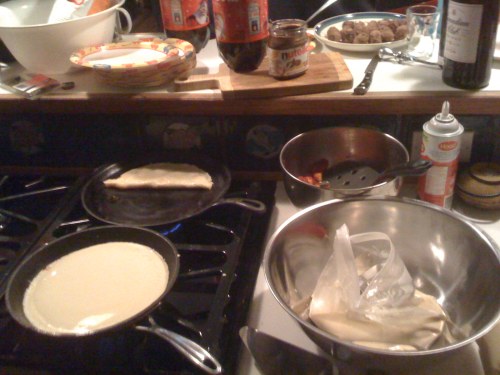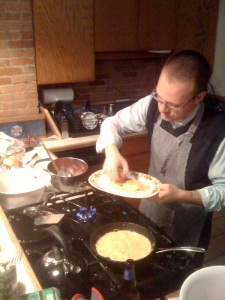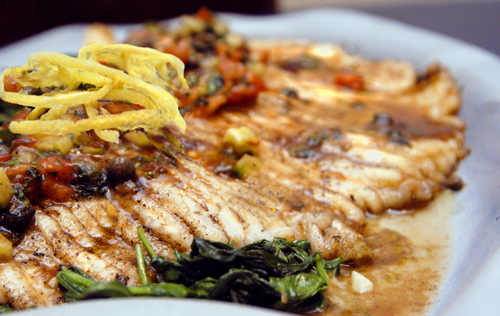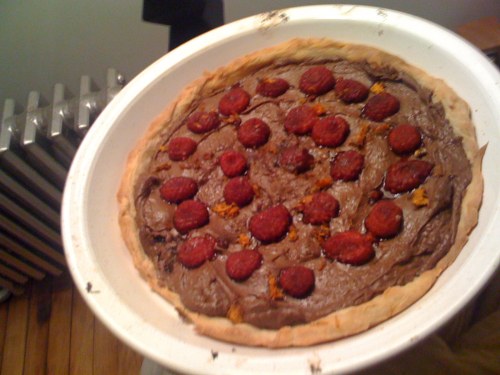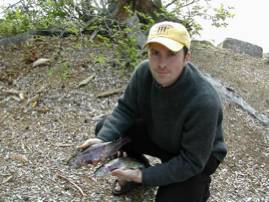One of the privileges of living in New England is the access to fresh fish from the Georges Bank and local waters. When the frigid temperatures of late January set in, I often find myself craving the hearty stews and baked dishes that epitomize some of the best seafood cuisine around. This past Sunday was no different. As I walked across the frozen fields of Dennehy Park in northern Cambridge, I fantasized about what I might find laid out on the ice.
Monkfish? More skate? Sole?A bag of mussels or fresh steamers from Maine?
When I arrived at the market, the mound of gleaming white filets at the center of the fish counter immediately drew my attention, not least because of the sale tag.

Cod Fish
Cod.
Cod is one of my favorite fish, though it is a species I’ve had a few qualms about eating after reading Mark Kurlansky’s excellent “Cod: A Biography of the Fish That Changed the World.” In that excellent tome, Kurlansky details the history of Gadus Gadidae, stretching back to the dark ages when the Vikings jigged for codfish by hand over the gunwhales of their longboats.
Unfortunately, in choosing cod for dinner I made a decision that would not please Seafood Watch. They’ve put cod ‘on the list of fish that sustainability-minded American consumers should avoid.’ I knew better. I let my hunger for the cod’s tender white flesh overcome my commitment to choosing from fish that have not been dramatically overfished.
All that being said, this dinner was one of the best I’ve made in some time. I knew I wanted to model the meal on a delectable dish my sister introduced to me years ago at Henninger’s in Fells Point, down in Baltimore’s Inner Harbor. Henninger’s pan-fried oysters with Pernod & fennel cream sauce remain one of the best things I’ve ever tasted, anywhere. I knew that my dish might not match that idealized first bite but I was determined to adapt its memory.
When I left the market, I’d collected a medium-sized filet of cod (1.2 lbs), a fennel bulb, a small container of heavy cream, a sweet onion, a bunch of ruby chard, a package of fresh wild mushrooms (oyster, shitake & porcini) and a lemon.
Before I went shopping, I’d split a butternut squash purchased the previous week, deseeded it, set it cut-side downwards in a baking tray with 1/3″ of water and put it into an oven heated to 350 degrees F. One hour later, the squash came out fork-tender.
I rubbed the filet with three large pinches of citrus salt, a kind gift from the very same sister, and set it aside.
I cooked the onion until it was just short of caramelized, sauteed the mushrooms in the same pan with a pat of salted butter and set both aside as well.
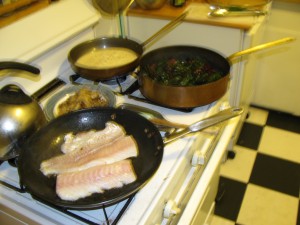
Cod, cream sauce & chard on the stove top
Finally, I shaved the fennel bulb with my chef’s knife and cooked it on medium high for a few minutes on each side, enough to add a bit of brown and fill the kitchen with the distintive, licorish-y aroma. I added enough white Bordeaux to cover the fennel, turned the heat to low, covered the pan and left the fennel to simmer and reduce. Fiftteen minutes later, I dumped the fennel slices, now translucent and tender, into a stainless steel bowl and used an immersion blender to combine them with 1/2 cup of cream.
I added that mixture to a saucepan and folded the onions and mushrooms in. I added a touch of salt and pepper, a bit more cream and some vegetable stock, andthen put it on the back burner.
Once the sauce was burbling away quietly, I focused on the fish and chard. I added safflower seed oil to a sauce pan and brought it to high heat, adding the cod when the oil was dancing. I cooked it on each side for two minutes, transferring the pan to a hot oven to finish the fish after I’d browned it and squeezed half of the lemon juice over the filets.
I’d cut the chard into thin strips, across the stalk, during prep. I added the shredded mass to some hot olive oil in a sauce pan, sprinkling a dash of soy sauce and balsamic vinegar and tossing it in.
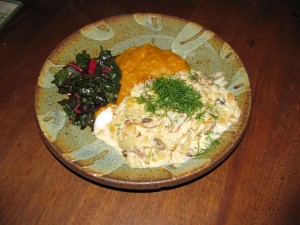
Cod with mushroom fennel cream sauce, squash & chard
While I was working on the above, my ‘sous chef’ had been busy with the butternut squash. I’d ground up rock salt, allspice, cinnamon and brown sugar in my mortar and pestle. Once added, the squash puree was a tad oversalted. That clever, creative sous chef mixed in half a jar of orange marmalade to balance the salt. The result was tangy, sweet and had delicious citrusy notes.
The final dish was better than I’d expected, though perhaps not the match of Henninger’s oysters. (I blame the absence of Pernod.) For once, there was very little I’d change in the preparation or cooking. A Sauvignon blanc might have been a better match than the white Bourdeaux but I enjoyed the combination of flavors. I would reconsider the use of cod, perhaps, as other species of white fish might do just as well under a mushroom fennel cream sauce. I’d love to add the sauce to crab cake, certainly, or even plebian chicken.
Next time. For now, I’m going to go enjoy the leftovers.


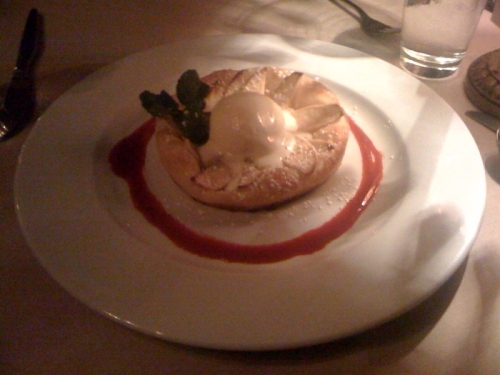
![Reblog this post [with Zemanta]](https://i0.wp.com/img.zemanta.com/reblog_e.png)
